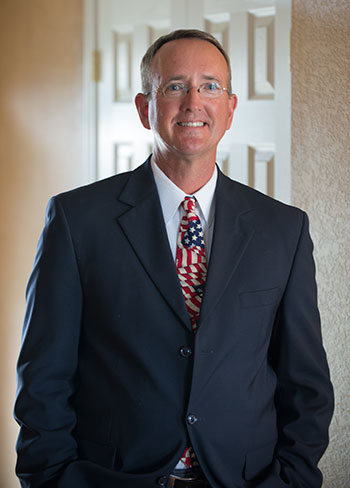An optimistic outlook for clients’ futures

Jim Pulley, LUTCF • Wichita Falls, TX
Questar Asset Management
Read full biography below
Proactive Advisor Magazine: Jim, what motivated you to expand from your insurance business into the investment advisory field?
First and foremost I saw it as a wonderful business opportunity. As part of my outreach for our insurance practice, I always made sure I was out and about in the community and involved in a number of community organizations. I enjoy networking and meeting new people.
I had the opportunity, through hard work and a little bit of good fortune, to be able to meet several high-net-worth families who had built their wealth through the oil industry. In working with these families and others, I saw so many people who had unfulfilled needs in the investment area and who were using what I considered to be an outdated investment approach. I decided to acquire my licenses and put my primary focus on retirement and investment planning. My wife now runs much of the insurance side of the business, and this arrangement has worked out well.

What were the needs you saw?
I think too many people were severely hurt by the last financial crisis, but did not know which way to turn for investment advice for the future. The old-school mentality of thinking you were diversified because you owned several different types of mutual funds may not have been a good solution for many people. Nearly all equities and other asset classes went down in 2008.
“The core idea of active management is having a system that constantly monitors market trends and sophisticated indicators, and taking action when required.”
 I have established a different approach for my firm through the use of outside money managers. This goes light-years beyond the notion of a client filling out a simple risk-profile questionnaire and then thinking their money was somehow being protected in the markets.
I have established a different approach for my firm through the use of outside money managers. This goes light-years beyond the notion of a client filling out a simple risk-profile questionnaire and then thinking their money was somehow being protected in the markets.
The core idea of money management, as I use it for my clients, is to have a system that constantly monitors market trends and sophisticated indicators, taking action when required. That in and of itself positions my firm differently than one that might have hundreds of clients that are all essentially in the same types of investments.
I have a lot of arrows in my quiver. I can first put together a financial plan that makes sense for many of the needs a family has for its future: life insurance and other insurance needs, college planning, retirement planning, and legacy planning—all with an eye to tax-advantaged approaches. We then can structure an investment plan that fits the financial plan and goals, helping to manage the risks inherent in any type of investment. As I have grown my advisory practice, it has been very gratifying to have a system that manages money for my clients that is truly based on their tolerance of risk.
Are there any downsides to this approach?
There are occasionally some concerns about management fees. That is both an objection and an opportunity for me. When I drill down with many new clients on what they are doing with their money, not doing with their money, their lack of a financial plan, and how all of the elements of their investments are probably not working in synch, it becomes fairly easy to explain the advantages of a holistic approach.
Though I do work with a good number of high-net-worth clients, the majority of my clients are middle class—just hardworking people for whom every dollar has to work as hard as possible. Most have never been through a systematic financial or investment planning process before. I find it is best usually to explain simple bucket-planning concepts that all come together in the end, showing how an integrated approach can help them better meet their financial needs.
When you look at this in the context of what they were previously doing, especially when the tax-advantaged piece is added, there really is no comparison either in terms of managing risk or the potential for growing their assets. Any concerns about management fees usually go away as we work through this process.
Do you look for specific qualities in a money manager?
I have invested a tremendous amount of time investigating active money managers—viewing presentations and webinars and meeting with representatives of firms that interest me. When I feel their approach matches the goals for my clients, I dig deeper into their methodology. I also on occasion consult with some of my associates in the industry.
Here are some questions I ask: How do these third-party firms philosophically approach investment management? What is their approach to risk? What is their track record? What kind of management tools, analysis, and models do they use? How long have they been using this approach? Then I want to look at other considerations such as their client support and the ease of doing business with them. In the final analysis, it is first and foremost about their investment approach and then about the way they conduct business. The bottom line is whether or not they will meet the needs of my clients in both of those areas.

What is the number-one client concern you hear today?
For the majority of my clients, it is the concern about funding the future, whether that means getting their kids through college, having income in retirement, or planning their legacy. The financial events over the last decade and a half have shaken up a lot of people. Many lost both a significant piece of their assets and their confidence as they look towards the future. They want an advisor who has their best interests at heart and who possesses access to the most sophisticated tools to manage their money through all kinds of market conditions. I think my practice delivers on both counts.
 Jim Pulley has been an investment advisor representative with Questar Capital Corporation since 2010. He and his wife Sheryl manage an insurance agency located in Wichita Falls, Texas, offering a wide range of personal and commercial coverages. Mr. Pulley focuses on investment and retirement planning in his advisory practice.
Jim Pulley has been an investment advisor representative with Questar Capital Corporation since 2010. He and his wife Sheryl manage an insurance agency located in Wichita Falls, Texas, offering a wide range of personal and commercial coverages. Mr. Pulley focuses on investment and retirement planning in his advisory practice.
Mr. Pulley grew up in Indiana and Ohio and began his career in manufacturing and sales. He later moved to Texas and was recruited by Prudential Insurance, where he worked for over ten years, moving rapidly into a managerial position; he then moved to New York Life. During the course of these business relationships, he established his own insurance and advisory firm.
Through a tragic event in his family, Mr. Pulley was motivated to write a book about the personal impact of spousal abuse. He has since become an active supporter of the movement to end domestic violence and created a website called “Pat Can Help.” He also volunteers with the First Step organization, which works within several communities around the U.S. on this issue. He speaks often on the topic.Mr. Pulley is deeply involved in his community and is an active member of the local Optimist Club and the Chamber of Commerce. He and his wife have three adult children and he says, “My kids and my grandchildren are a constant inspiration to my wife and me.”
Disclosure: Securities offered through Questar Capital Corporation (QCC), Member FINRA, SIPC. Advisory Services offered through Questar Asset Management (QAM), a Registered Investment Advisor.
Photography by Robert Hart

